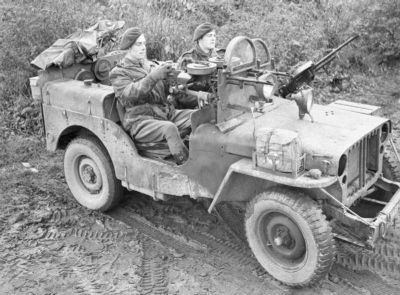The Auxiliary Units played a significant part in the history of the wartime Special Air Service. Given the secrecy around the modern SAS, it is perhaps surprising that men were happy to talk about their SAS service in World War Two, but not their Auxiliary Unit service. However, the wartime SAS was not so secretive. Indeed there were a number of photo features of the men operating behind enemy lines in the national press.
The SAS was formed in the desert in 1941, with those serving from the start known as the Originals. With the end of the desert fighting, and the capture of its founder David Stirling, the immediate purpose of the SAS seemed to have gone. It morphed into the SRS (Special Raiding Squadron) and SBS (Special Boat Squadron), both serving in the Mediterranean. In late 1943, after considerable lobbying, the SAS were authorised to form two British & Commonwealth regiments, 1 SAS and 2 SAS Regiment, under the auspices of the Army Air Corps. 3 SAS and 4 SAS were French regiments, with 5 SAS a Belgian squadron. The SRS men became part of 1 SAS, but additional troops were required.

Legendary SAS commander Colonel Blair "Paddy" Mayne became aware that there were a large number of men from the Auxiliary Unit Scout Sections recently returned to their units but already trained in fighting behind enemy lines and in demolition. He invited them to London, where they were told about the SAS and asked to volunteer. According to Peter Weaver, former Dorset Scout Section Officer, around 130 men joined from Auxiliary Units. The Official History of Airborne Forces quoted the figure of nearly 300 recruited from a "special auxiliary force" disbanding at the time.
These included around 30 Auxiliary Units officers. Major Peter Forbes recalled attending the Curzon cinema with Major Dick Bond, the training officer. Major Forbes volunteered but was rejected because a pre-war accident meant his arm was fixed at the elbow, making it difficult for him to use a parachute. Somerset Intelligence Officer (IO) Ian Fenwick and Sussex IO Roy Bradford did join. Brigadier Mike Calvert, who had helped found Kent's Aux Units, would command the SAS Brigade at the end of the war.
The men of the Scout Sections were invited to a selection board at the Grosvenor Hotel in Park Lane, London where they were interviewed and asked to join. Many joined from across the country, though quite a few of the former personnel were already serving overseas or in other elite units such as the Glider Pilots regiment, where their specialist skills could not be spared.
It is also known that a number of men from the Auxiliary Units Home Guard Patrols also joined SAS. Again they appear to have been specifically recruited. Norfolk Auxilier John Fielding recalled that when he was called up, he found himself training with large numbers of other former Auxiliers who, after their basic training, were offered the chance to go directly into the SAS. Auxiliers from Dorset, Essex, Somerset, Yorkshire, Morayshire and Monmouthshire are known to have followed a similar route.
The message seems to have gone a little further than intended in some areas. Many Home Guard patrols recalled being asked if they would be willing to be dropped behind the lines in France. Some refused, recognising that their local knowledge advantage would be lost in a foreign country. Others were keen but heard no more. Auxiliary Units Commanding Officer, Colonel Frank Douglas, was reportedly furious that Colonel Mayne had come in whilst he was on leave to pinch some of his best men.